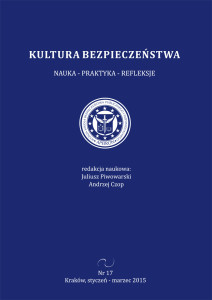EKSPRESYJNY WYMIAR SZTUK WALKI
EXPRESSIONAL DIMENSION OF MARTIAL ART
Author(s): Wojciech J. CynarskiSubject(s): Security and defense
Published by: Wyższa Szkoła Bezpieczeństwa Publicznego i Indywidualnego “Apeiron” w Krakowie
Keywords: martial arts;theatre;chain of connections;record of the movement;archetype;ritual of movement;self-expression;performative phenomenon;
Summary/Abstract: The author presents the mythical and archetypical roots common for martial arts and theatre. He also describes Far-Eastern rituals and theatre, the film of martial arts, the relations of martial arts with dance, as well as aesthetical and meta-aesthetical relations. He writes about knowledge encoded in movement, in the forms of martial arts. These forms are close to theatrical performance. The record of the technical fighting movement (Jap. kata), passed on in unchanged form through centuries, makes the one who exercises the martial arts almost an actor. It is known otherwise, that everyone executes, a given form differently adding elements of his own personality to it. The article contains the reflection based on the humanistic theory of Far-Eastern martial arts and many years author’s experience in training practice. The Chinese, Japanese or Korean martial arts transfer in form of the “kata” the technical and tactical knowledge of the former masters, experience from performed fights, but also a large load of cultural and symbolic knowledge which hides in names the gestures and spiritual dimension of its practice. Similarly to the theatre, Far-Eastern martial arts originate from (or they reflect strong connection with) magic and religious rituals, what can be observed on the example of sumō wrestling. It is possible to formulate here the chain of connections: magic – ritual – dance – theatre, and, further – the cinema and film
Journal: Kultura Bezpieczeństwa. Nauka-Praktyka-Refleksje
- Issue Year: 2017
- Issue No: 17
- Page Range: 21-39
- Page Count: 19
- Language: Polish

